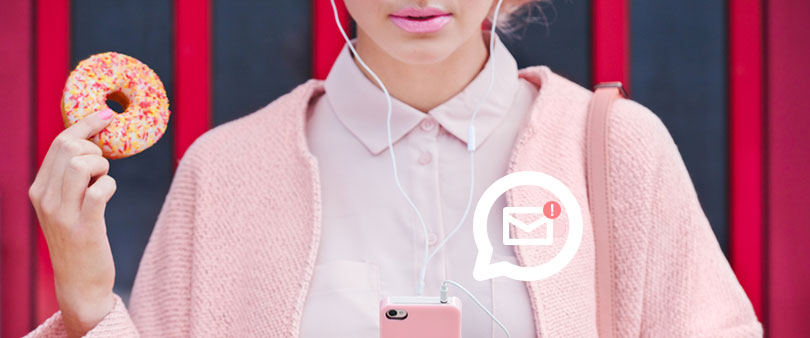Get More Sales with These 5 Email Receipt Marketing Tactics

Every time someone makes a purchase from your store they get an email receipt.
It’s an amazing way to connect with your customers—but it’s often overlooked as a marketing opportunity.
Chances are, you’re missing out on sales because of that.
In this post, we’ll take a look at how you can use email receipt templates as a part of your marketing strategy to win additional sales, and stay connected with your customers.
Let's get into it!
What’s Your Email Receipt Missing?
With an open rate of 70.90%, compared to the average 17.19% for regular email marketing campaigns—email receipts are a potential ecommerce gold mine, and it's important that you treat it as such.
It's important to remember that when a customer completes a checkout on your store, their trust is at its fullest. They’ve already committed to your product and brand.
You can use that moment when a customer opens their email to do a few things:
- Upsell related products in your store
- Offer a discount code to incentivize a future purchase
- Set up a feedback loop to better understand your customers and your checkout flow
- Promote your social media accounts
- Let customers share their purchase on Facebook
- Much, much more
It might not seem obvious, but companies have been using email receipts as a part of their marketing strategy for a while now.
Even companies outside of the ecommerce space.
Take a look at an email receipt that I received from Uber the other day. See if there’s anything here that you can draw inspiration from.

Uber is giving their customers a fantastic product experience (travel), and then utilize their email receipts as a marketing tool by:
- Letting you rate your experience
- Being able to provide immediate feedback on your "purchase"
- Offer a referral bonus for sharing with friends
- Include a valuable, and fun insight into their “product” (travel) using Google Maps
Still not convinced these are powerful? Here's what Uber has to say about their customer acquisition and marketing strategy:
Uber spends virtually zero dollars on marketing, spreading almost exclusively via word of mouth. Our virality is almost unprecedented. For every 7 rides we do, our users’ big mouths generate a new rider.
Let’s dig in a bit deeper and take a look at some specific ecommerce email receipt strategies you can start implementing today—and who knows, maybe you'll see some "Uber" growth.
1. Use Email Receipts as a Way to Upsell Related Products
Some big players in the ecommerce industry have already been doing this for a while.
For example, as far back as 2006 Amazon, reported that 35% of its revenues were as a direct result of its cross sales and up selling efforts. That’s mostly through email receipts.
Here's an example of what an upsell might look like in an email receipt template:

Try incorporating some product up selling in your email receipt template to see if there is an increase in orders.
Here are some examples of other ways you can use this idea in email receipts:
- Add the option for a subscription purchase
- Sell related products, or accessories
- Offer the option to buy it for a friend as a gift
Additional resources:
Read more about upselling products to increase sales
Try using an app like Receiptful to create an email receipt template
Learn more about Shopify's email notification templates
Read more about upselling products to increase sales
Try using an app like Receiptful to create an email receipt template
Learn more about Shopify's email notification templates
2. Offer a Discount Code to Incentivize a Future Purchase
By offering a discount code in your receipt email, you’re offering an incentive for the customer to come back and make another purchase.
A study shows that 44% of email recipients made at least one purchase last year based on a promotional email that included a coupon code.
Here's an example of a content block from an app called Receiptful that generates a unique coupon code for each customer that makes a purchase:

Even if the discount is something as small as 5%, or $1 off their next order, savings are savings—and in the mind of a consumer, any savings are good.
Another thing to consider about coupons as a promotional tool, is that they have multiple uses. You can use them to:
- Track sales for online and offline marketing campaigns
- Offer time-sensitive discounts to incentivize another purchase
- Include them on your physical retail receipts
Additional resources:
Learn more about the discount code engine in Shopify
Use Receiptful to add content cards and upsells in your order confirmation emails
Learn more about the discount code engine in Shopify
Use Receiptful to add content cards and upsells in your order confirmation emails
3. Promote Your Social Media Accounts to Keep Customers Informed
A study by MarketingProfs shows that more than two-thirds of business leaders plan to integrate social media within their email marketing efforts.
So why aren't you?
Simply include links to your social accounts in either the footer, or in a content card on your email receipt template.
Here's an example of how The North Face includes their social accounts in their email receipt templates:

While it is a fairly basic way to use a receipt email—there are other opportunities around social media here as well.
Some ideas are:
- Share with 10 friends and get 10% off your next order
- Every time you refer a friend, you get $1 off your next order
- Every time you refer a friend and they make a purchase, your next order is free
The number of different variations goes on, so consider testing a few different strategies to see which ones stick and generate sales and high engagement.
Additional resources:
Use an app like Referral Candy to setup a referral campaign
Try using a service like S Loyalty to create a loyalty program for your customers
Use an app like Referral Candy to setup a referral campaign
Try using a service like S Loyalty to create a loyalty program for your customers
4. Get Immediate Feedback from Paying Customers
You can get immediate, valuable feedback from paying customers using email receipts. Retail stores and restaurants have been doing this for a long time. Often, they'll include a contest entry by completing a feedback survey. You can do the same for your online store.
This will give you some insight into the purchasing flow for your store, as well as any pain points a customer may have experienced during the checkout process.
Take a look at this email that solicits feedback from customers of Warby Parker:

Here are some questions that might be worth including to get some feedback from your customers:
- How did they feel about the overall purchasing process?
- Did they feel the product was fairly priced?
- How did they find your store?
- When do they expect the product to be delivered?
- How can you improve your checkout flow?
Additional resources:
Use follow-up emails to ask for feedback from paying customers
Try using an abandoned cart feature to retain customers, and ask for feedback as to why they didn't complete their checkout
Use follow-up emails to ask for feedback from paying customers
Try using an abandoned cart feature to retain customers, and ask for feedback as to why they didn't complete their checkout
5. Have Customers Share Their Purchase on Facebook
Shopping makes anyone feel good. Research shows that shopping activates key areas of the brain, which boosts moods and triggers the release of brain chemicals that give you a "shopping high".
Using email receipts, you can take advantage of that brief moment when dopamine is released into the brain.
Try to encourage customers to share their purchase on Facebook when they're still feeling excited and have a "shopping high".
Here's an example of what this might look like from the team at AddShoppers:

In a previous post, we discovered how powerful referral campaigns are. By including this in your email receipt, you're making it easier for customers to refer their friends.
Why is it important to make it easily sharable? Because customers who have been referred by their friends spend on average 13.4% more.
Additional resources:
Use a service like Friendbuy to create a referral campaign
Take a look at AddShoppers to create a "Share Purchase on Facebook" campaign
Use a service like Friendbuy to create a referral campaign
Take a look at AddShoppers to create a "Share Purchase on Facebook" campaign
Conclusion
Now that we’ve taken a look at some of the ways you can use email receipts to sell more, how will you incorporate this into your marketing strategy?
Are there any other tactics you can think of? Let us know in the comments below.

About The Author
Tucker Schreiber is an ecommerce entrepreneur and content crafter at Shopify. He writes to inspire, educate, and inform readers on all things commerce.










